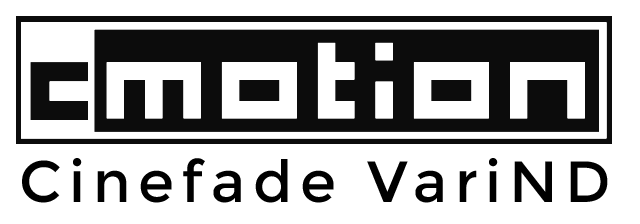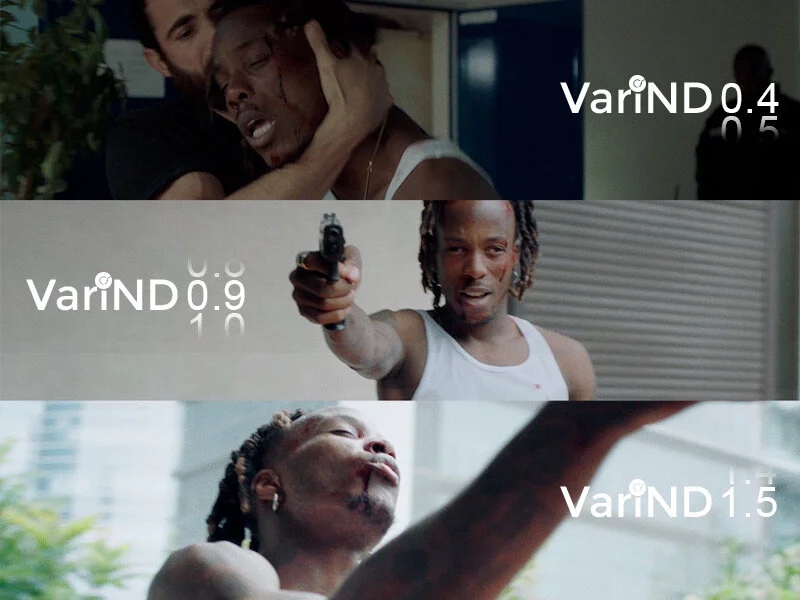Motorised variable ND filter for professional film productions
The novel Cinefade system synchronises the external iris motor of a professional camera system with the cmotion Cinefade VariND to vary depth-of-field in film.
The Cinefade VariND can also be used individually as a motorised variable ND filter that is remotely controlled by a cmotion cPRO lens control system to allow for precise and fast exposure changes when the camera is inaccessible or when doing interior to exterior transition shots.
There are surprisingly few options available for professional filmmakers who want to use a variable ND filter on professional digital or analogue film camera systems, such as an ARRI Alexa, RED or Panavision camera.
The Cinefade VariND system can be used on any camera and cine-lens. It consists of two polarising filters which sit inside a matte box. One of the filters remains static while the other is rotated with an in-built motor.
The setup is quick with plug-and-play simplicity and operating the unit is very easy.
The Cinefade VariND is able to attenuate up to 5+ stops of light with an initial light loss of 1.5 stops at full transmission without any colour cast.
VARIABLE ND FILTER FOR SHOOTING IN CHANGING AND UNPREDICTABLE LIGHTING ENVIRONMENTS
There is no need to waste time by constantly changing between full ND filters when you can quickly and easily control your ND value with a variable ND filter.
AC Rafa Miralles is often asked to change between ND filters depending on ever changing lighting situations. It was a real time-saver when he was able to benefit from a variable ND filter that allowed him and DP Harry Patramanis to dial in the required level of ND on set at a fraction of the time it would take to switch out full ND filters.
“I no longer have to run between the camera and filter case to switch out the ND filters when the sun suddenly comes out from behind the clouds.”
Shooting a commercial for pharmaceutical brand 'Linzess' in Barcelona, DP Harry Patramanis wanted to capture an unscheduled plane fly-by at sunset with unpredictable cloud coverage.
He used the Cinefade variable ND filter to keep a well exposed image, making constant adjustments as the sun came out from and then disappeared behind the clouds.
“It was easy to quickly adjust the exposure while the sun was coming in and out from behind the clouds while we were waiting to hear if and when the plane would fly past our location.”
VARIABLE ND FILTER TO KEEP A CONSTANT STOP
Depth-of-field is an important creative aspect for cinematographers and can define the look of a project. The current trend towards using large format cameras, such as the Panavision DXL2, Sony Venice and Arri Alexa LF and 65 means DPs are embracing a very shallow depth-of-field look and are often shooting with a wide open aperture.
In order to keep a consistent look throughout a project, DPs want to shoot at the same T-stop under any lighting environment, making ND filters an integral part of any kit list.
A variable ND filter negates the need for a full set of ND filters and allows for small exposure adjustments without changing the T-stop and affecting depth-of-field. Full-stop ND filters are not able to provide that same level of control.
On the set of The Commuter (2018) DIT Tom Gough got excited at the possibilities that a variable ND filter could provide.
“Making precise exposure adjustments to maintain a good exposure while keeping the same stop on the lens would be a great tool to have on any film production.”
DP Dimitri Karakatsanis used the Cinefade variable ND filter on a commercial for Walmart, which allowed him and AC Jesse Cain to work faster and make more precise exposure adjustments to maintain their stop.
“The Tiffen MRT is not ideal as it only mounts in the larger MB18 or MB20 matte box. It has less stop adjustment and is not as easy to use as the Cinefade variable ND filter.”
VARIABLE ND FILTER FOR CREATIVE INTERIOR TO EXTERIOR SHOT - NO MORE IRIS PULLS!
When transitioning from dark to bright lighting conditions, most filmmakers employ an iris pull during the transition from one lighting extreme to the other to maintain a good exposure. This drastically changes depth-of-field and has always been a drawback that DPs have had to accept.
The Cinefade VariND is remotely controlled, so even if the camera is mounted on a Steadicam, the exposure can be adjusted to maintain a well exposed image during the transition from a dark interior to a bright exterior lighting environment with a consistent stop, allowing for a shallow depth-of-field inside as well as outside and maintaining the look of the project.
The variable ND filter is remotely controlled by the Camera Assistant from the cmotion hand unit that also controls focus and iris and is easy and fast to set up and operate. The AC sets marks for both positions of the variable ND filter and manually moves the slider (or knob) between them during the transition, similar to setting marks for and executing a focus pull.
In the following video, DP Asselin Gauthier transitions from inside a building into bright daylight in one single Steadicam shot, using the Cinefade VariND to maintain a stop of T2.8 on the lens while keeping a good exposure throughout.
VARIABLE ND FILTER ON RUSSIAN ARM, CRANE OR HELICOPTER
Cine-lenses have geared aperture and focus rings allowing motors to be attached to them. Wireless lens control systems control their position so that the AC does not have to physically stand next to the lens. This is especially useful when the camera is mounted on a Steadicam or when it is inaccessible and hard to reach, such as on a Russian Arm, crane or helicopter etc.
The Cinefade VariND has a motor built in so that the AC can remotely control the filter’s rotation angle using the cPRO lens control system. The system is fast to setup with plug-and-play simplicity, enabling the DP and AC to control the exact value of ND required from a distance.
The filters fit into most matte boxes, including the Arri LMB5/25, 4x5 matte boxes and take up two stages, one for the static polariser and one for the Motorised Polariser.
Visit www.cinefade.com to find out more about our system, which is available to rent or buy directly from Cinefade.
Follow us on social media or get in touch with Oliver and let us know how a variable ND filter would benefit your production and let us know about creative ways you would use the system








